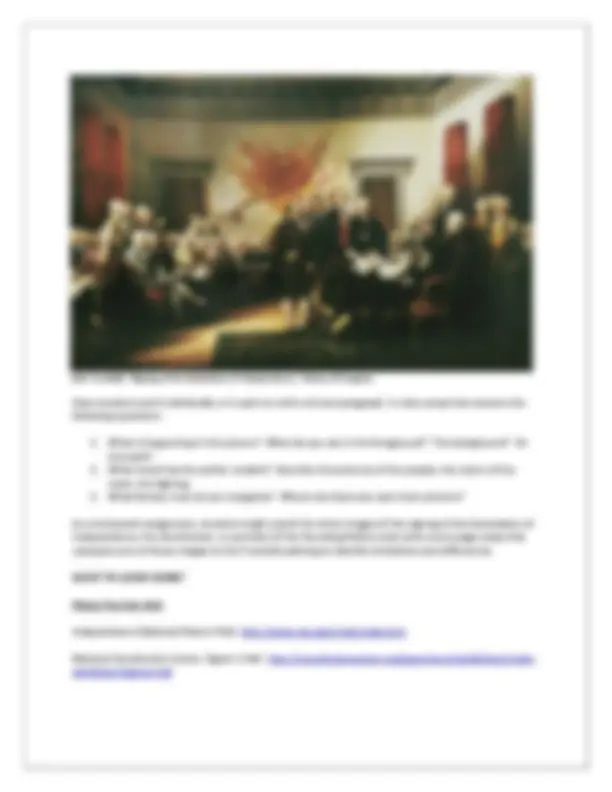





Study with the several resources on Docsity

Earn points by helping other students or get them with a premium plan


Prepare for your exams
Study with the several resources on Docsity

Earn points to download
Earn points by helping other students or get them with a premium plan
Community
Ask the community for help and clear up your study doubts
Discover the best universities in your country according to Docsity users
Free resources
Download our free guides on studying techniques, anxiety management strategies, and thesis advice from Docsity tutors
Background information on the New Jersey Plan proposed by William Paterson during the US Constitutional Convention in 1787. The plan aimed to give equal power to every state, regardless of population, in contrast to the Virginia Plan. The document also discusses the compromise that led to the creation of the bicameral legislative system, including the House of Representatives and the Senate.
What you will learn
Typology: Study notes
1 / 6

This page cannot be seen from the preview
Don't miss anything!




Target Age: Elementary (Grades 3-5) Time Period: 18 th^ Century Featured County: Somerset NJ 350th^ Theme: Liberty
Common Core State Standards for English Language Arts: R.CCR.2- Determine central ideas or themes of a text and analyze their development; summarize the key supporting details and ideas
W.CCR.2- Write informative/explanatory texts to examine and convey complex ideas and information clearly and accurately through the effective selection, organization, and analysis of content.
SL.CCR.1- Prepare for and participate effectively in a range of conversations and collaborations with diverse partners, building on others' ideas and expressing their own clearly and persuasively.
New Jersey Core Curriculum Content Standards: Social Studies: 6.1.12.A.2.b, 6.1.12.A.2.f, 6.1.12.B.2.a
What role did New Jersey play in defining how representation is measured in national governance?
As the nation’s top political leaders gathered in Philadelphia in 1787 to devise a new plan of government for the young republic, small states like New Jersey had much to fear. Large states, especially Virginia, seemed intent on dominating the new government. But small states had an advocate in William Paterson from New Jersey. Paterson had studied law at Princeton University, then called the College of New Jersey, before he joined the patriot movement and eventually represented New Jersey in the Constitutional Convention. He is probably best known, however, as the author of “The Small State Plan,” alternately called “The New Jersey Plan” or “The Paterson Plan,” proposed on June 15, 1787. The document was a response to the Virginia Plan, which would have given proportional power to the states based on their number of citizens. The key feature of Patterson’s proposal was giving equal power to every state, regardless of population.
Congressional delegates initially rejected the Paterson plan, but it was ultimately incorporated into what became known as “The Great Compromise,” a two-house (or bi-cameral) legislative system that included both a branch based on relative population size based on one representative for every 30,000 people in a state, (the House of Representatives) and a branch offering equal representation from every state (the Senate).
New Jersey State House Portrait Collection, Administered by the New Jersey State Museum SHPC Reproduced with permission.
The “Great Compromise” was one of many issues that Congress faced. They also debated questions about trade (such as the “Commerce Compromise,” which arose because northern states wanted to tax both imports and exports, while the southern states disagreed; the compromise allowed only imported goods to be taxed), the “Twenty-Years Compromise” (that stated that the legislative branch would leave slave trade untouched for twenty years, but then may impose taxes in 1808), and most notably the “Three-Fifths Compromise.” Southern states did not want slaves to have rights, but did want slaves to be counted as part of their populace in order to increase the number a representatives they had in the House, particularly as the “Great Compromise” mandated that the number of congressional representatives in the lower house would be directly keyed to population. The “Three-Fifths Compromise” ultimately held that each enslaved man or woman would count as three- fifth of a person when calculating the number of a state’s legislators.
Paterson went on to serve as governor of New Jersey and was appointed to the Supreme Court by George Washington. He died in 1806. Ironically, New Jersey would have been well served under the Virginia Plan. With 8.8 million residents in 2013, it is the eleventh most populous state in the country, with a total of fourteen electoral votes.
Prior to class, print and cut out the boxes provided below with the state and number of delegates. Print out one for each student (it is okay to have more than one of each state—there are only 13 boxes below, so you might well have two “representatives” from each state).
Number of delegates for each state at the 1787 Constitutional Convention Massachusetts (4 delegates) New Hampshire (2 delegates)
New York (3 delegates) South Carolina (4 delegates)
Pennsylvania (8 delegates) Georgia (4 delegates)
Virginia (7 delegates) New Jersey (5 delegates)
North Carolina (5 delegates) Connecticut (3 delegates)
Delaware (5 delegates) Maryland (5 delegates)
Rhode Island boycotted the Convention (zero
delegates)
On the board, write a question about a topic students would find interesting. You may choose one of the suggestions below, or you can ask students to form their own. Regardless of which question you select, be sure that there are at least three possible “answers.”
What is the most important social media network (Facebook, Twitter, Instagram)? What is the best game to play at recess? What is the most popular show on television?
Have students work individually or in pairs to write a three-paragraph, in-class essay that answers the following questions:
As a homework assignment, students might search for other images of the signing of the Declaration of Independence, the Constitution, or portraits of the Founding Fathers and write a one-page essay that compares one of those images to the Trumball painting to identify similarities and differences.
Places You Can Visit
Independence National Historic Park: http://www.nps.gov/inde/index.htm
National Constitution Center, Signer’s Hall: http://constitutioncenter.org/experience/exhibitions/main- exhibition/signers-hall
John Trumball, “Signing of the Declaration of Independence,” Library of Congress.
More Classroom Activities
Constitutional Convention- a Decision Making Activity: This lesson, designed for 8th grade social studies students, offers into the Constitutional Convention of 1787 and the issues faced by the delegates. http://ssecamoreperfectunion.com/PDFs/Constitutional_Convention_Lesson_Plan_Web_Version_by_Pa vao.pdf
Four Founding Fathers You May Have Never Met: This lesson will introduces four key, but relatively unknown, contributors to the U.S. Constitution: Oliver Ellsworth, Alexander Hamilton, William Paterson, and Edmund Randolph: http://edsitement.neh.gov/lesson-plan/constitutional-convention-four- founding-fathers-you-may-never-have-met#sect-thelesson
The Constitutional Convention, the Great Compromise: This engaging 5-minute video (with a quiz and a transcript) examines the Great Compromise that designed the bicameral congress the U.S. has today. http://education-portal.com/academy/lesson/the-constitutional-convention-the-great- compromise.html
For More Information
Richard Beeman, Plain, Honest Men: The Making of the American Constitution (New York: Random House, 2010).
Catherine Dinker Bowen, Miracle at Philadelphia: The Story of the Constitutional Convention May to September 1787 (New York: Little, Brown, and Company, 1966).
Michael Kammen. The Origins of the American Constitution: A Documentary History (New York: Penguin Books, 1986).
John O’Connor, William Paterson: Lawyer and Statesman (New Brunswick: Rutgers University Press, 1986).
Library of Congress, The New Jersey Plan (original primary document): http://memory.loc.gov/cgi-bin/ampage?collId=llfr&fileName=003/llfr003.db&recNum=
New Jersey and the Making of the Constitution, Monmouth University (a concise explanation of the two plans): http://zorak.monmouth.edu/~njhist/njconstconvention.html
Teaching with Documents—The Signers of the Constitution: http://www.archives.gov/education/lessons/constitution-day/signers.html